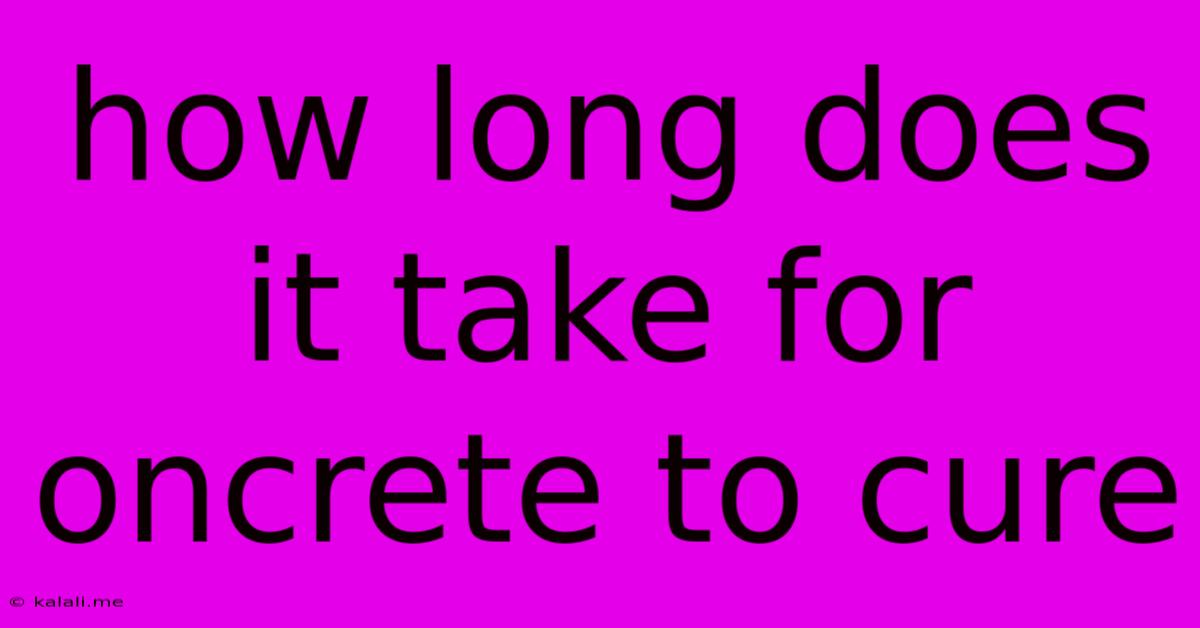How Long Does It Take For Oncrete To Cure
Kalali
Jun 09, 2025 · 4 min read

Table of Contents
How Long Does it Take for Concrete to Cure? A Comprehensive Guide
Concrete is a ubiquitous building material, forming the foundation of countless structures. Understanding its curing process is crucial for ensuring the longevity and structural integrity of any project, whether it's a small patio or a massive skyscraper. But how long does it actually take for concrete to cure? The answer isn't a simple number, as several factors influence the curing time. This comprehensive guide will explore the intricacies of concrete curing, providing you with the knowledge to make informed decisions.
What is Concrete Curing?
Concrete curing isn't simply about waiting for the water to evaporate. It's a chemical process where the cement hydration reaction continues, leading to increased strength and durability. This reaction requires moisture and heat, and the duration depends on several factors. Proper curing is vital for achieving the desired compressive strength and minimizing cracking, ensuring the concrete's long-term performance. Failure to cure concrete properly can result in significant structural problems down the line.
Factors Affecting Concrete Curing Time
Several factors influence how long it takes for concrete to cure completely:
-
Cement Type: Different types of cement have varying hydration rates. Portland cement, the most common type, typically requires a longer curing period than other types. High-early-strength cement, for example, cures much faster.
-
Water-Cement Ratio: A lower water-cement ratio results in a stronger, more durable concrete that cures more quickly. However, using too little water can make the concrete difficult to work with.
-
Ambient Temperature: Higher temperatures generally accelerate the curing process, while lower temperatures slow it down. Extremely cold temperatures can even halt the hydration reaction completely. This is why many concrete projects are put on hold during winter.
-
Relative Humidity: Maintaining high relative humidity around the concrete helps retain moisture, which is essential for the hydration process. Low humidity can lead to rapid evaporation, weakening the concrete.
-
Concrete Admixtures: Chemical admixtures can be added to concrete to modify its properties, including its curing time. Some admixtures accelerate curing, while others retard it.
-
Thickness of the Concrete Pour: Thicker pours take longer to cure fully because the heat generated by the hydration reaction takes longer to dissipate.
Stages of Concrete Curing
While the overall curing process is ongoing, we can break it down into several stages:
-
Initial Setting: This is the period immediately after pouring, where the concrete begins to lose its plasticity and becomes firm. This typically happens within a few hours.
-
Early Strength Development: During this stage, the concrete gains a significant portion of its ultimate strength. This typically occurs within the first few days.
-
Continued Strength Gain: The concrete continues to gain strength over several weeks and even months. While much of the strength is achieved in the initial days, the curing process continues to improve the long-term properties of the concrete.
-
Final Strength: This stage represents the point where the concrete reaches its maximum compressive strength, specified by the mix design.
How Long Until I Can Walk On It?
A common question is, "How soon can I walk on newly poured concrete?" This largely depends on the thickness and type of concrete, as well as environmental conditions. Generally, it's advisable to avoid walking on concrete for at least 24 hours, preferably longer. Heavier foot traffic should be avoided for at least a week.
How Long for Full Cure?
For most applications, concrete reaches a sufficient level of strength for most purposes within 28 days. However, it continues to gain strength for many months, even years, after that. For critical structural applications, a longer curing period may be necessary, and testing may be required to confirm the strength has reached specified design values.
Maintaining Proper Curing
Proper curing is critical for achieving the desired results. Methods include:
-
Water Curing: Keeping the concrete surface consistently moist by spraying it with water or covering it with wet burlap.
-
Membrane Curing: Applying a curing compound to the concrete surface to retain moisture.
-
Steam Curing: Used in precast concrete plants to accelerate the curing process.
By understanding the factors that influence concrete curing time and employing proper curing techniques, you can ensure the strength, durability, and longevity of your concrete projects. Remember, patience is key—allowing sufficient curing time is crucial for a successful outcome.
Latest Posts
Latest Posts
-
Wish Merry Christmas And Happy New Year
Jun 09, 2025
-
I Cant See Anything Through Eclipse Glasses
Jun 09, 2025
-
Two Planes Orthogonal To A Third Plane Are Parallel
Jun 09, 2025
-
Is An Eye For An Eye The Old Law
Jun 09, 2025
-
Do I Need To Put A Suffix On Application
Jun 09, 2025
Related Post
Thank you for visiting our website which covers about How Long Does It Take For Oncrete To Cure . We hope the information provided has been useful to you. Feel free to contact us if you have any questions or need further assistance. See you next time and don't miss to bookmark.